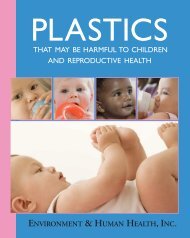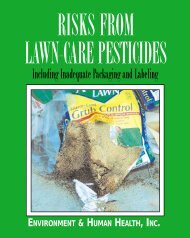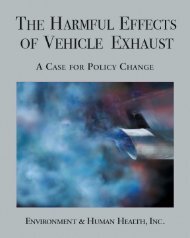LEED Report - Environment & Human Health, Inc.
LEED Report - Environment & Human Health, Inc.
LEED Report - Environment & Human Health, Inc.
- No tags were found...
Create successful ePaper yourself
Turn your PDF publications into a flip-book with our unique Google optimized e-Paper software.
The Green Building DebateIII.<strong>Health</strong> Threats Neglectedby the <strong>LEED</strong> Rating SystemThe Green Building Council requires that all certified projects complywith existing environmental laws. The United States has one of themost complex bodies of environmental law in the world, and althoughmany believe that these laws and regulations provide protection forhuman health, this is not the case. Hazardous chemicals are often usedin consumer products, as well as in commonly used building materials.Among many serious problems is the failure of the Toxic SubstancesControl Act (TSCA) that was adopted in 1976 to help EPA maintain aninventory of potentially toxic substances. The agency is not empoweredto demand pre-market testing or to regulate the production of chemicalsunless it has compelling evidence that these compounds have significantenvironmental or health risks. Therefore, the burden on governmentis to conduct the testing needed to justify regulation, and this taskis now impossible given the staggering number of untested chemicalsand combinations that have been released into the environment.When TSCA went into effect, 62,000 chemicals were alreadyin commerce and were therefore listed, but immediately exempted orgrandfathered from any data submission requirements. Nearly 20,000additional chemicals have been introduced into commerce since then,yet almost half were not reported to the EPA until after companiesbegan to sell them. EPA has required companies to submit data todemonstrate product safety for only 200 of these chemicals, and it hasused TSCA authority to ban only five compounds since 1976.Hazardous chemicals areoften used in consumerproducts, as well as incommonly used buildingmaterials. Among manyserious problems isthe failure of the ToxicSubstances Control Actthat was adopted in1976 to help EPAmaintain an inventoryof potentially toxicsubstances. The agencyis not empowered todemand pre-market testing.As a result of this neglect, 90 percent of U.S. chemicals produced in thehighest volumes are exempt from federal review under TSCA. Moreover,in 1998 the EPA found that basic toxicity information was available foronly seven percent of them, and no toxicity data was available for morethan 40 percent. For chemicals produced at lower volumes, the agencyhad even less information.15







